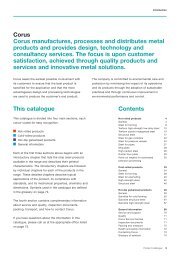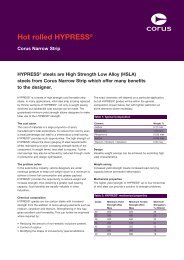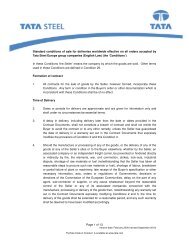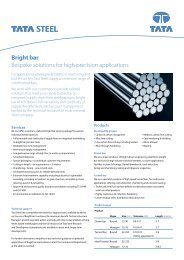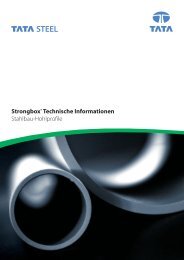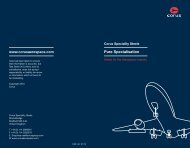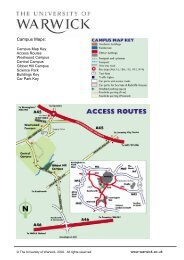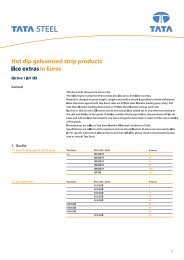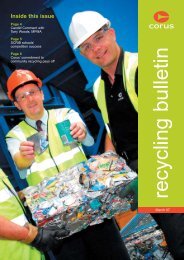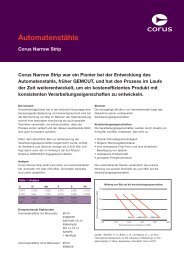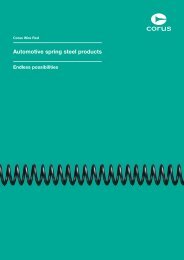Corporate responsibility report 2004 - Tata Steel
Corporate responsibility report 2004 - Tata Steel
Corporate responsibility report 2004 - Tata Steel
You also want an ePaper? Increase the reach of your titles
YUMPU automatically turns print PDFs into web optimized ePapers that Google loves.
Environment<br />
Table 2 Releases to water<br />
– Corus Group (tonnes/year)<br />
Substance 1999 <strong>2004</strong><br />
Suspended solids 3,500 1,750<br />
Arsenic 1.27 0.31<br />
Cadmium 0.14 0.07<br />
Chromium 2.01 1.36<br />
Copper 1.18 1.27*<br />
Lead 4.64 2.65<br />
Mercury 0.06 0.04<br />
Nickel 1.79 1.87*<br />
Zinc 8.18 21.76*<br />
*The apparent increase compared to 1999<br />
for some heavy metals is due to improved<br />
monitoring and extended <strong>report</strong>ing.<br />
Figure 9 Emissions to water relative to 1999<br />
(per tonne of steel)<br />
100<br />
80<br />
60<br />
40<br />
20<br />
0<br />
1999 2000 2001 2002 2003 <strong>2004</strong><br />
Suspended solids<br />
Arsenic<br />
Lead<br />
Table 3 Resource use<br />
(million tonnes/year)<br />
1999 <strong>2004</strong><br />
<strong>Steel</strong> production 21 19.3<br />
Aluminium production 0.5 0.5<br />
Iron ore 29 26<br />
Coal 12 10.6<br />
Coke 0.5 1.3<br />
Fuel oil 0.6 0.3<br />
Limestone/lime products 4.4 3.8<br />
Alumina 0.5 0.4<br />
Data is approximate and is shown only to<br />
illustrate typical usage.<br />
Water<br />
Relatively large amounts of water are<br />
used during the manufacture of steel,<br />
although this is difficult to quantify. We<br />
estimate that our iron and steelmaking<br />
sites use between 5 and 10 m 3 of<br />
water per tonne of steel produced.<br />
Water conservation is a key objective<br />
at many of our sites and significant<br />
improvements have been made over<br />
recent years. For example, Apollo<br />
Metals in the USA, which is part of<br />
Corus Special Strip, has developed<br />
a novel vertical rinsing system that has<br />
reduced water consumption by more<br />
than 50%, whilst improving both<br />
energy efficiency and product quality.<br />
Most of our water is used in indirect<br />
non-contact cooling circuits or is<br />
treated before discharge back into<br />
natural watercourses.<br />
We aim to minimise the impact from<br />
our effluents wherever this is cost<br />
effective and practicable. For<br />
example, at Corus Strip Products,<br />
IJmuiden, we installed a new<br />
treatment unit at our pellet plant<br />
during <strong>2004</strong> to remove arsenic.<br />
In addition, releases of chromium,<br />
copper, nickel, mercury and<br />
cadmium have also been reduced.<br />
Table 2 compares releases to water in<br />
<strong>2004</strong> with those in 1999. Some of our<br />
key emissions are also presented in<br />
normalised form in Figure 9.<br />
Resource effectiveness<br />
We are committed to improving<br />
the efficiency with which we use the<br />
earth’s resources. This is a fundamental<br />
aspect of sustainable development<br />
and is one of our key policy principles.<br />
Our primary raw materials for steel<br />
production are iron ore, coal, coke,<br />
limestone and oil. Alumina is the<br />
primary raw material in the aluminium<br />
smelting process. Table 3 shows<br />
our consumption of these materials<br />
during <strong>2004</strong>. We have developed<br />
systems to maximise the internal<br />
recycling of materials containing<br />
iron and/or carbon that are<br />
unavoidably produced in our<br />
steelmaking processes (for example,<br />
the briquetting of dust collected in<br />
our emissions control equipment).<br />
We have not set a specific target<br />
to reduce our consumption of raw<br />
materials, but we have set a target<br />
to reduce our waste to landfill. This<br />
target will largely be achieved through<br />
increased recycling rates within our<br />
processes, which will also result in<br />
reduced raw materials consumption.<br />
We are continually developing techniques<br />
for reducing water use.<br />
<strong>Corporate</strong> <strong>responsibility</strong> <strong>report</strong> 23




